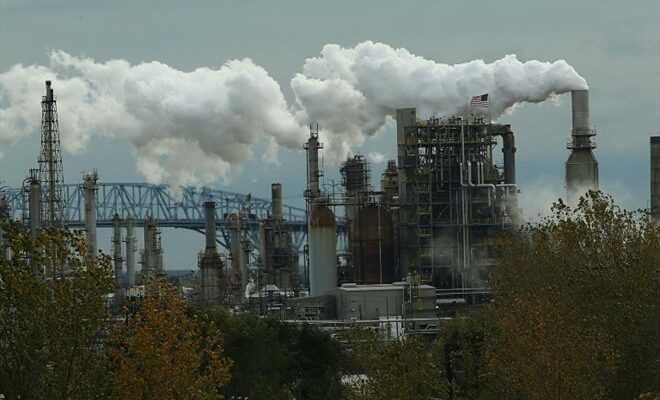The PES refinery in Philadelphia, hit by an explosion in 2019 (GETTY IMAGES NORTH AMERICA/AFP/SPENCER PLATT)
Despite record gasoline prices in the United States, American refineries are unable to catch up with demand, due to a lack of sufficient capacity, after a series of closures in recent years, contributing to the surge in fuel prices.
Last week, the utilization rate of refineries in the United States rose to 93.2%, the highest since December 2019, breaking with the tradition of a month of May usually dedicated to maintenance, with limited use installations.
However, American gasoline reserves have fallen further, to a level not seen at this time of the year for eight years, while this weekend, a holiday in the United States (Memorial Day), marks the start of the main road travel season.
“We are going to bankrupt” the system, warns Robert Yawger, an analyst at Mizuho Securities.
“The lack of capacity to convert” oil into fuel, which adds to the take-off in crude prices, “has caused refining prices to rise massively (…) in recent months and led to record prices for the gasoline and diesel”, according to the firm Eurasia Group.
Gasoline prices are at historic highs in the United States, up more than 70% year on year. JPMorgan Chase analysts even see it soar by more than 30% during the summer, to more than 6 dollars per gallon (3.78 liters).
The number of refineries in operation has fallen by 13% in ten years and is now the lowest in the modern era.
In addition to the planned closures, there was the explosion of the PES refinery in Philadelphia, the largest facility in the northeastern United States, in June 2019, which was followed by the final condemnation of the site.
“It’s a growing concern in the United States, because we’ve lost more than a million barrels a day of capacity in one year,” said Andy Lipow of Lipow Oil Associates.
In the early months of the pandemic, some sites had been closed to adjust to the slowdown in demand, but not all of them have since been returned to service, such as that of Gallup (New Mexico), owned by Marathon Petroleum.
Most of the major refiners have initiated the conversion of some of their equipment to produce biofuel, which leads to the temporary suspension of their activities.
And in the case of HollyFrontier, the transition to renewable fuel has, for example, increased the capacity of its facility in Cheyenne, Wyoming, from 52,000 to 6,000 barrels per day.
– “It smells bad” –
Structural tensions have been further heightened by the war in Ukraine, which has pushed part of the West to do without Russia, a major supplier of refined products, particularly diesel.
This situation has led to increased export demand for fuel produced in the United States, and further unbalanced the relationship between supply and demand.
“You could rebuild capacity in the northeast (…), but these are investments that should be made profitable over 10 or 20 years”, advances Richard Sweeney, professor of environmental economics at Boston College. “The general trend is one of an industry in decline.”
“A refinery takes five or six years to build, (…) knowing that the demand for your products is probably going to go down,” agrees Bill O’Grady, of Confluence Investment Management, “so there is very little incentive to invest”.
Many of the major American refiners have chosen to devote a significant part of their current profits to share buybacks and the payment of dividends rather than to massive investments.
The last opening of a major refinery in the United States dates back to 1977, and only five new sites have been inaugurated over the past twenty years.
“What further complicates the problem is that no community wants a refinery” on its territory, underlines Bill O’Grady. “It’s dirty, it can explode, it smells bad.”
“Governments are trying to become more environmentally responsible and discourage investment in refining (…) but we end up with a shortage of capacity”, argues Phil Flynn of Price Futures Group.
For him, “we will have to find a balance between our ESG dreams (environmental, social and governance criteria) and the reality of trying to supply the market” with petroleum products, while waiting for the supply of renewable energy is sufficient to replace it.
© 2022 AFP
Did you like this article ? Share it with your friends with the buttons below.




